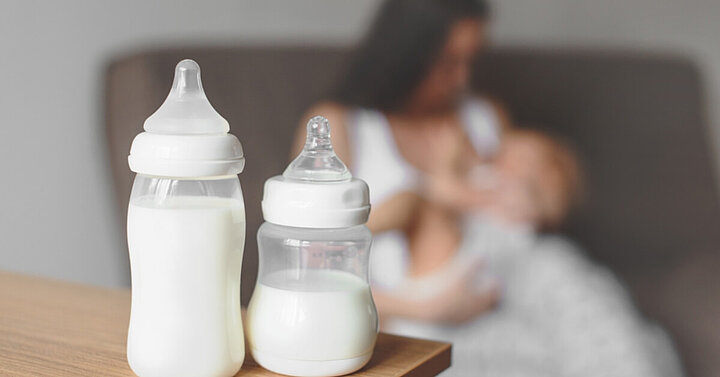Combination feeding
Feeding | | Louise Broadbridge
What is combination feeding?
Combination feeding is the term given to using a mixture of bottles and breastfeeds to feed your baby. While exclusive breastfeeding is when a baby gets all their milk directly from the breast, combination feeding involves other methods like bottles or cups.
Some people choose to combination feed from birth, while others may look to gradually introduce bottles alongside breastfeeding when their baby gets older. There are lots of different reasons people may combination feed.
Mixed feeding may be necessary due to people’s circumstances – for example, if you are going back to work and won’t be on hand to breastfeed. Other new parents may prefer the idea of offering a combination of breast or bottle so that they can both be involved in feeding, or it may even have been recommended by a medical professional if there are concerns about the baby’s weight gain.
Whether you decide to combination feed, exclusively breastfeed or bottle feed is ultimately down to a personal choice and your own set of circumstances. However, any choice you make should be an informed decision and it is important to realise there are both advantages and disadvantages that come with combination feeding.
Why do some parents try combination feeding?
One of the main benefits of combination feeding is that you can share the workload of feeding your baby. This means that you don’t have to be physically there for every feed, as your partner or another loved one can give your baby either expressed breast milk or formula milk in a bottle.
This can be extremely helpful in the unlikely event that you are unwell when your baby is young and you are unable to physically care for them all the time. It is also a good idea if you are returning to work and will be away from your little one for long periods of time.
If your baby is gaining weight very slowly or perhaps not gaining at all, you may be advised to express some of your breastmilk and give it to your baby with a cup or bottle so you can supplement your breastfeeds. It may also be advised, if expressing doesn’t seem to yield much milk, to supplement baby with formula.
In these circumstances, it is usually recommended to try breastfeeding first and then offer a bottle after the feed to make sure your baby is getting enough.
If you or your baby are finding breastfeeding difficult, combination feeding can offer a halfway house between struggling on as you are and giving up completely. Every breastfeed you can give your baby comes with enormous benefits, so if including bottles in your routine allows you to continue for longer than you would otherwise, this can only be a good thing. That said, once breastfeeding is established, it shouldn’t be such a huge struggle, so try to get as much support as possible to help resolve any challenges you are experiencing. Although breastfeeding can be tough, it can also be an amazing and fulfilling experience.
Are there any downsides to combination feeding?
Most parenting decisions will come with a set of pros and cons. While the benefits of combination feeding are that you can monitor how much milk your baby is taking and share the feeding responsibilities with others, there are also some disadvantages you need to be aware of.
It is also worth noting that our desire to know how much milk our babies are getting is often a result of lack of confidence in the process. If you can, try to attend a comprehensive infant feeding class that teaches you how to recognise the signs of good milk volume transfer (i.e. the signs your baby is emptying your breast) as understanding these things will really help alleviate your concerns.
The more you breastfeed the easier it becomes, as you and your baby will become more comfortable with the technique. Breastfeeding is also important for building your milk supply – the more breast milk your baby drinks, the more your body will produce.
Any amount of formula feeding is likely to impact your milk supply. However, if you are offering formula and are worried about your milk supply, you could spend some time expressing whilst your baby is having their formula feed to keep the demand present.
It is recommended that you establish breastfeeding for the first few weeks before changing to combination feeding. This is partly for the benefit of encouraging your milk, and partly because babies use a very different technique to extract milk from the nipple than they do to take it from the teat of a bottle.
Some new parents will find that their newborn seems to struggle with breastfeeding if they have also been using a bottle to feed, as babies can experience what is known as nipple confusion. Older babies who are experienced breastfeeders usually find it easier to switch between nipples and teats without a problem.
Our advice would be to hold off making changes between 4 – 6 weeks if possible. That way baby will be a pro at breastfeeding and likely take to the teat a little better. That said, this is not a hard and fast rule. If starting combination feed earlier helps you to keep offering some breastfeeds for longer, all well and good. You really are in the driving seat.
If you are giving your baby expressed milk in a bottle, it is important to remember that not all women are able to express large quantities of milk. The amount of milk you produce using a manual or electric breast pump is not always the same as the amount your baby would get during a breastfeeding session. This often depends on how relaxed you are during the expressing process. If you’re feeling very tense, you are less likely to express great volumes of milk.
Expressing can also be more time-consuming and takes quite a bit of planning. It is ideal if you need to be away from your baby but want them to still benefit from your breastmilk, but you will need to express regularly when you’re not breastfeeding to safeguard your milk supply.
How do I introduce a bottle?
Feeding from a bottle will feel very different to a baby who is accustomed to breastfeeding. Some babies will initially refuse to take a bottle at all and it can take them a while to get used to a different method of feeding.
If you have decided you want to switch from exclusive breastfeeding to mixed feeding, it is a good idea to get someone else to offer the bottle at first. This is because your baby will be able to smell your milk and will get frustrated that you are not allowing them to latch on and feed as normal.
Don’t wait until your baby is hungry to offer the bottle when you are first introducing bottle feeding. Your little one is more likely to try something new if they are calm and happy than if they are already starting to become distressed. It may be that you start the feed on the breast and then pass baby over to finish with the bottle.
Be patient – your baby needs to learn how to take milk from a bottle just as they needed to learn to breastfeed. It’s also important to not become focused on getting your baby to finish the bottle – allow them to indicate when they have finished, just as you would if they were on the breast.
If you are starting to use formula for the first time, take time to read the instructions on the packet to ensure you are making the feeds up correctly. And remember to thoroughly clean and then sterilise the bottles you use every time.
Introduce formula gradually so your little one can get used to the new milk and keep an eye out for any adverse reactions. If you switch over to offering multiple bottles of formula a day all at once, your breasts are likely to become engorged and painful and you will increase your risk of getting mastitis.
Can I switch back to the breast once I have introduced a bottle?
Every baby is different and while some will switch easily between breast and bottle, others will find that more challenging. Once you start using a bottle, you might find it harder to get your baby to latch on and breastfeed as usual.
However, stick with it and continue offering the breast. You may also find that having plenty of skin-to-skin time will encourage your little one to get back to breastfeeding.
If you try combination feeding and then decide you want to return to exclusive breastfeeding, this is usually possible so long as you are still producing milk. If you have been giving expressed milk, this is usually easier than if you have been using formula, as your milk supply will still match your baby’s needs.
If you have been using formula and want to stop, you will have to reduce this gradually and work on building your milk supply back up. Always offer the breast first at each feed and slowly cut down on how much formula you give.
Remember that there is lots of breastfeeding support and advice out there so don’t struggle on alone. Speak to your midwife, health visitor or breastfeeding support worker for advice or call a breastfeeding helpline.
Is it normal to feel emotional about combination feeding?
How you feel about combination or mixed feeding will probably depend on the reasons you have for doing it. Looking after a young baby and making parenting decisions is tough and it is natural to feel a whole range of emotions.
If you had hoped to exclusively breastfeed until six months, you may experience feelings of disappointment and even guilt about introducing a bottle. Remember, you are simply doing your best for your baby and there is nothing to feel guilty about.
The most important thing is that you and your baby are happy and healthy. What works well for one parent might not work so well for another, so don’t compare yourself to anyone else and just make the decision which makes the most sense for you and your circumstances.


